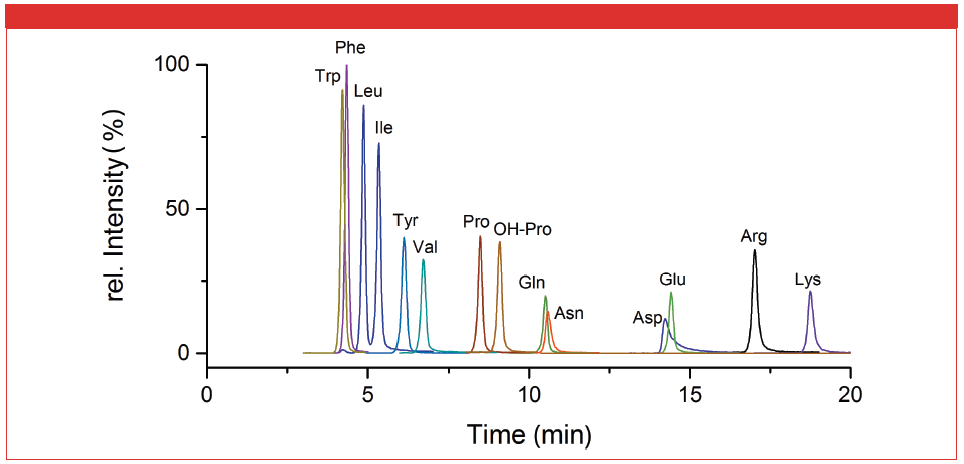Flavour Profiling of Beverages Using Probe-Based Sorptive Extraction and Thermal Desorption–GC–MS
The Application Notebook
This study shows that the organic compounds giving rise to the flavour of a variety of beverages can be identified by high-capacity sorptive extraction using PDMS probes, with analysis by thermal desorption–GC–MS.
Lara Kelly and David Barden, Markes International
This study shows that the organic compounds giving rise to the flavour of a variety of beverages can be identified by high-capacity sorptive extraction using PDMS probes, with analysis by thermal desorption–GC–MS.
Introduction
Analysis of volatile and semi-volatile organic compounds (VOCs and SVOCs) in foods and beverages is important for quality control and product development and characterization. It is widely studied using GC, but this is hindered by the limitations of existing sample preparation techniques.
Markes International’s PDMS HiSorb™ probes allow immersive sorptive extraction from liquids (or headspace sorptive extraction from solids), without the expense of time associated with solventâextraction methods, and with lower detection limits than SPME.
Figure 1: The HiSorb probe.
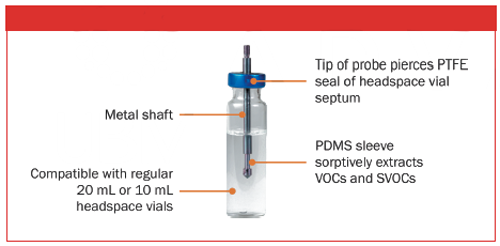
In these three studies, a HiSorb probe (Figure 1) was immersed into a sample of the beverage in a 20 mL headspace vial. The vial and probe were agitated on a HiSorb Agitator at 40 °C for 1 h, and the probe was then washed, dried, and inserted into a TD tube for desorption. Analysis used a TD100-xr™ thermal desorber (Markes International), with GC–MS. Full details-and further examples showing the analysis of milk and premium teas-are available from http://chem.markes.com/HiSorb
Sorptive Extraction and TD–GC–MS Analysis of Beverages
Filter Coffee (Figure 2): Furans typically have caramel-like aromas, and a number of these are present in this sample. Nitrogenâcontaining compounds are also of particular importance to coffee aroma, with pyridine (#4), pyrroles (#11, #13), pyrazoles (#18), and pyrazines (#5, #8) being found in this sample. However, pyrazines can be common in defective coffee beans, and some of them may contribute undesirable flavours.
Figure 2: TD-GC-MS flavour profile of filter coffee.
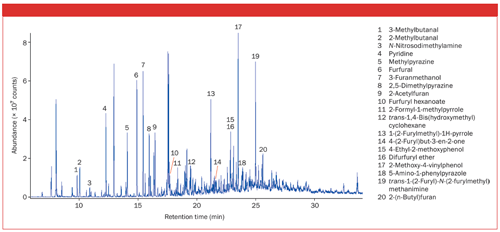
Herbal Infusions (Figure 3): Monoterpenoids are key components of the aroma and flavour of mint products, and these feature prominently in the peppermint infusion (A). The peppermint and nettle infusion (B) is very similar, except for the loss of two C8 alcohols (#1, #2) and the addition of the norsesquiterpene cyprotene (#19).
Figure 3: TD-GC-MS flavour profile of two herbal infusions.
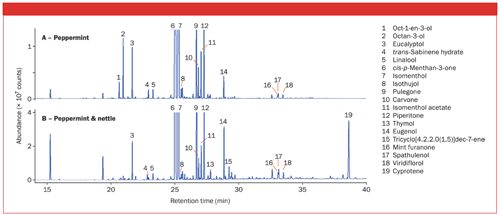
Scotch Whisky (Figure 4): This analysis shows the ability of the HiSorb probe to sample compounds at high and low levels. The profile is dominated by medium-chain esters that likely contribute substantially to the flavour, while phenylethyl alcohol (#6, which is known to impart a floral note) is also of interest.
Figure 4: TD-GC-MS flavour profile of Scotch whisky. The inset shows the full-scale profile. S = Siloxane.
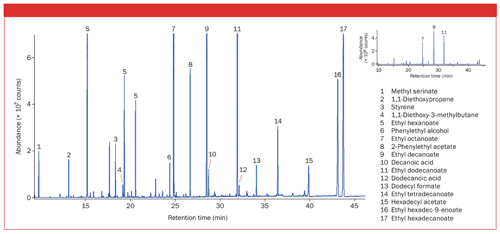
Conclusions
HiSorb probes are an easy-to-use, highly sensitive approach to the sorptive extraction of VOCs and SVOCs from a range of sample types, including water-based solutions, emulsions, and suspensions, as well as solids. Unattended sample preparation using the HiSorb Agitator, with automated analysis by thermal desorption (TD), ensures maximum productivity, while reusable probes and tubes minimize the cost per sample.

Markes International
Gwaun Elai Medi-Science Campus, Llantrisant, Wales, UK
Tel.: +44 (0)1443 230935
E-mail:enquiries@markes.comWebsite:www.markes.com
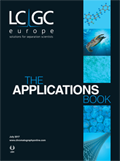
New Study Reviews Chromatography Methods for Flavonoid Analysis
April 21st 2025Flavonoids are widely used metabolites that carry out various functions in different industries, such as food and cosmetics. Detecting, separating, and quantifying them in fruit species can be a complicated process.
Analytical Challenges in Measuring Migration from Food Contact Materials
November 2nd 2015Food contact materials contain low molecular weight additives and processing aids which can migrate into foods leading to trace levels of contamination. Food safety is ensured through regulations, comprising compositional controls and migration limits, which present a significant analytical challenge to the food industry to ensure compliance and demonstrate due diligence. Of the various analytical approaches, LC-MS/MS has proved to be an essential tool in monitoring migration of target compounds into foods, and more sophisticated approaches such as LC-high resolution MS (Orbitrap) are being increasingly used for untargeted analysis to monitor non-intentionally added substances. This podcast will provide an overview to this area, illustrated with various applications showing current approaches being employed.

.png&w=3840&q=75)

.png&w=3840&q=75)



.png&w=3840&q=75)



.png&w=3840&q=75)




